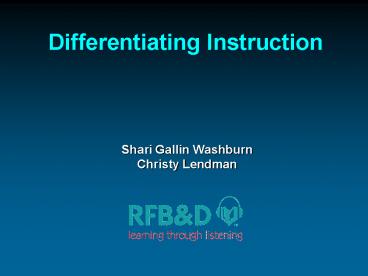Differentiating Instruction - PowerPoint PPT Presentation
1 / 31
Title:
Differentiating Instruction
Description:
Differentiated Instruction. A Philosophy cont. ... Data that drives differentiated instruction ... Key Principles of Differentiating Instruction cont. ... – PowerPoint PPT presentation
Number of Views:80
Avg rating:3.0/5.0
Title: Differentiating Instruction
1
Differentiating Instruction
- Shari Gallin Washburn Christy Lendman
2
A New Look at Blooms
Evaluation
Analysis
Knowledge Comprehension
Synthesis
Application
3
A New Look at Blooms cont.
- Critical thought processes are interrelated and
interactive - Critical thought has knowledge and comprehension
at the center - Critical thought builds knowledge
- The full range of thinking skills may be involved
when learning
4
Differentiated Instruction
5
What Gets Differentiated?
CONTENT What students should Know Understand Be able to do
PROCESS How students will Create their own understanding of the concept Construct their knowledge
PRODUCT Demonstration of knowledge
6
Differentiated Instruction A Philosophy
- Students differ in their
- Readiness
- Interests
- Learning styles
adapted from C.Tomlinson, ASCD, Sept., 2000
7
Differentiated Instruction A Philosophy cont.
- Students require varied
- Knowledge
- Pace
- Supports
adapted from C.Tomlinson, ASCD, Sept., 2000
8
Differentiated Instruction A Philosophy cont.
- Students learn best when
- Challenged
- They make connections
- Learning is authentic
- There is a community of respect
adapted from C.Tomlinson, ASCD, Sept., 2000
9
Setting Goals
- Let standards be your guide
- Clarify the essentials
- Goal vs. demonstration
- Skills vs. content knowledge
10
Pre-Assessment
- Data that drives differentiated instruction
- Empowers you to make learning appropriately
challenging - Assess for readiness, interest, and learning
styles
11
Pre-assessment should
- Be reasonable in length
- Include all of the skills in the unit
- Be easy to interpret
- Be open-ended when appropriate
- Be on-going
12
(No Transcript)
13
Pre-Assessment cont.
Readiness Interests Learning
Coursework
Surveys
Concept maps
KWL
Skill Quizzes
Story telling
Observations
Inventories
Interviews
Logs
Journals
Checklists
Inventories
4MAT
Checklists
Choice
14
Now What?
- Flexible grouping
- Tiering
- Stations and Centers
- Contracts and Compacts
15
Flexible Grouping Principles
- Group based on readiness, interests, learning
styles - Keep the group size small (3-5)
16
Flexible Grouping Principles cont.
- Keep groups flexible
- Vary level and pace
- Change membership
- Teach group social skills
- Turn-taking
- Accountability
17
Tiering
- Leveling activities while maintaining
- the same essential goal.
18
Tiering Principles
- Students work on the same
- Essential idea
- Key skills
19
Tiering Principles cont.
- Students work at different levels of
- Complexity
- Abstractness
- Open-endedness
20
Tiering Principles cont.
- Should include problem-solving
- That is teacher facilitated
- Through a wide range of activities
21
Tiering Principles cont.
- Activities are
- Open-ended
- Appropriate to readiness
- Require complex exploration with appropriate
supports
22
The Activity Ladder
High skill complexity
Low skill complexity
- Chart the complexity of a current activity
- Determine what supports, materials, connections,
timelines, resources, application, and monitoring
will enable activity to be more or less complex - Clone the activity
23
Cloning a Lesson The Tiering Continuum
- 1st Tier 2nd Tier 3rd Tier
- Concrete ideas Abstract ideas
- Teacher plans, designs, Student plans,
- and monitors activities designs, and
monitors activities - Structure use of Discovery through
- manipulatives manipulatives
24
Learning Stations
- Different areas within the classroom
- All stations work in concert with each other
- Symmetry
- Angles
- Geoboards
- Tangrams
- Tessellations
25
Learning Stations cont.
- Students work on various tasks simultaneously
- Incorporate flexible grouping
- Within the station different tasks
- Schedule rotation
- Different combinations of stations
- Different lengths of time
26
Centers
- Teach, reinforce, or extend a particular skill or
concept - Focus on mastery
- Vary activity types for different
- Readiness levels
- Learning styles
- Interests
27
Contracts Compacting
- Negotiated Agreement
- Content delineates
- Skills
- Working conditions
- Consequences
- Outcome criteria
- Signatures/
- accountability
- Assess prior knowledge
- Identify unknowns
- Student buys-back time for an alternative
activity - Challenging
- Meaningful
28
How to Begin?
- Start small
- Slowly but surely
- Envision and predict
- Reflect and assess
29
Key Principles of Differentiating Instruction
- Teacher clarifies important subject matter
- Assessment and instruction are inseparable
- Goals
- Maximum growth
- Individual success
30
Key Principles of Differentiating Instruction
cont.
- CONTENT, PROCESS and PRODUCTS are adjusted
according to student - Readiness
- Interests
- Learning style
31
Key Principles of Differentiating Instruction
cont.
- Teacher recognizes and appreciates student
diversity - Community of respect
- Teachers and students collaborate
- Work is challenging and meaningful for all
students (UnequalFair) - Flexibility!
- Adapted from C. Tomlinson, The Differentiated
Classroom, 1999.































